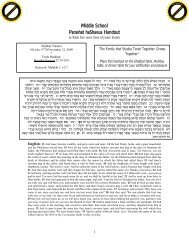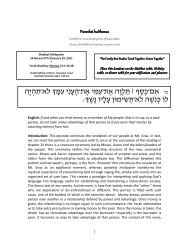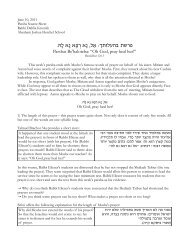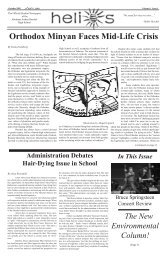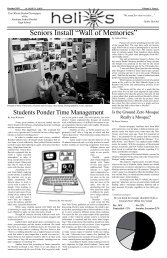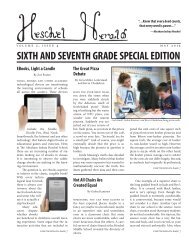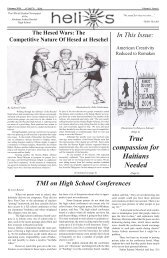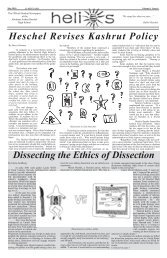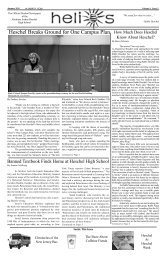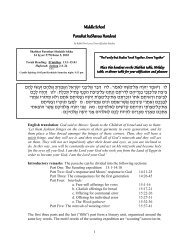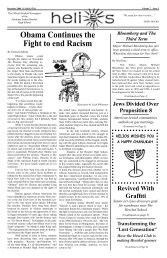Volume 1, Issue 5 (June 2011) - The Heschel School
Volume 1, Issue 5 (June 2011) - The Heschel School
Volume 1, Issue 5 (June 2011) - The Heschel School
You also want an ePaper? Increase the reach of your titles
YUMPU automatically turns print PDFs into web optimized ePapers that Google loves.
“…Know that every deed counts,<br />
that every word is power…”<br />
—Abraham Joshua <strong>Heschel</strong><br />
V o l u m e 1 , I s s u e 5 J u n e 2 0 1 1<br />
<strong>Heschel</strong> Eighth Grader Takes<br />
Home the Gold<br />
By Coby Goldberg<br />
<strong>The</strong> G-Word<br />
By Dylan Posner<br />
It happens every year to the eighth<br />
grade. After they have bonded through<br />
Early Childhood, Lower <strong>School</strong>, Middle<br />
<strong>School</strong>, and through their Israel trip,<br />
they must say goodbye to this part of<br />
their lives. This year, it has happening<br />
to an 8th grade that has become a thoroughly<br />
bonded group. Did it happen<br />
during the two grade-wide snow day gettogethers,<br />
or during the movies we saw<br />
together? Whatever the reason, this tight<br />
group feels that their connection was<br />
torn apart by the g-word, graduation.<br />
About half of the current eighth<br />
grade is not returning to <strong>Heschel</strong> High.<br />
After the end of the year, the unified<br />
grade will go its separate ways. Most fear<br />
that high school will get in the way, and<br />
students will lose connections to one another.<br />
Luckily, the eighth grade has remarkable<br />
memories of its time together.<br />
<strong>The</strong> Graduation Ceremony took<br />
place on <strong>June</strong> 14. Jordan Ofek said, a bit<br />
teary eyed, “Graduation makes me feel<br />
that I’m done here, at <strong>Heschel</strong>, and I’m<br />
taking the next step in life.” Jordan is<br />
using the theme of commencement, as<br />
a beginning and a start of something<br />
new. Numerous eighth graders have remarked<br />
that the Middle <strong>School</strong> has been<br />
one of their favorite places, and it is quite<br />
upsetting and depressing to leave it. One<br />
student, Orly Silverstein, put it this way,<br />
“I’m excited about graduating, but there<br />
is a part of me that wishes we could all<br />
just stay at the Middle <strong>School</strong>.”<br />
After classes for the eighth grade<br />
concluded, on <strong>June</strong> 6, students dove<br />
into an intense week rehearsing for the<br />
ceremony. Anna Savant wrote the script,<br />
using three questionnaires based on the<br />
Middle <strong>School</strong> “experience”: education,<br />
friendships, and the Israel trip.<br />
Anna Savant, director, Joe Ancowitz,<br />
the music director, and Lori Skopp,<br />
the Middle <strong>School</strong> principal, designed a<br />
ceremony that they hope will be remembered<br />
for many years by parents, family,<br />
and friends.<br />
It is certain that all the eighth graders<br />
cherished their graduation, as they<br />
go their separate directions for High<br />
<strong>School</strong>, and will never forget the friends<br />
they’ve made, and memories they have<br />
of <strong>Heschel</strong>. ◆<br />
On Monday, May 23, eighth grader<br />
Jonathan Granowitz won First Place in<br />
the Gotham Games long jump competition.<br />
His winning jump measured 5.2<br />
meters or 17 feet. <strong>The</strong> Gotham Games<br />
are a competition for the City’s best<br />
private school track and field athletes.<br />
To compete in the Gotham games, the<br />
athlete must place in the top sixteen in<br />
a qualifying event. Despite a stellar performance<br />
in the games themselves, the<br />
qualifying process was not made easy for<br />
Granowitz; he had to go to the qualifying<br />
meet only a few hours after his arrival<br />
back in New York from Israel. After<br />
almost jumping five meters in the qualifiers<br />
(he jumped 4.94 meters), Granowitz<br />
said he, “set a goal of jumping five meters.<br />
It felt fulfilling to reach that goal.”<br />
Once all the competitors had<br />
jumped three times, Granowitz was<br />
pronounced the official winner. An announcement<br />
was then made on the Middle<br />
<strong>School</strong> loudspeaker that he had won.<br />
Rick Munn had this to say, “Jumping<br />
17 feet is pretty impressive. When I was<br />
doing long jump with fifth graders in<br />
school I set out three mats… I told them<br />
Continued on page 3
2010-<strong>2011</strong><br />
Editors<br />
Coby Goldberg<br />
Daniel Ernst<br />
Daniella Nevid<br />
Sydney Shaiman<br />
Contributing Writers<br />
Alexa Ringer<br />
Aliza Astrow<br />
Amelia Sylvor-Greenberg<br />
Ariella Kahan<br />
Benjamin Shapiro<br />
Benjamin Sternklar-Davis<br />
Chloe Weinstein<br />
Dylan Posner<br />
Eliana Salmon<br />
Ella Kaplun<br />
Hallie Fawer<br />
Hannah Zhukovsky<br />
Jonathan Mack<br />
Laura Glesby<br />
Mirina Rosen<br />
Nico Miller<br />
Noah Shapiro<br />
Ronen Schatsky<br />
Sasha Chanko<br />
Sonia Epstein<br />
Artists<br />
Lizzy Kaner<br />
Orly Silverstein<br />
Photographers<br />
Karen Dorr<br />
Daniel Ernst<br />
Judy Katz<br />
Rick Munn<br />
Faculty Advisor<br />
Karen Dorr<br />
Layout & Design<br />
Abe Hendin<br />
Letter from the Editors<br />
Dear <strong>Heschel</strong> Middle <strong>School</strong>,<br />
It’s hard to believe that a whole<br />
school year has gone by since the beginning<br />
of the <strong>Heschel</strong> Herald. At the beginning<br />
of this year, the <strong>Heschel</strong> Herald was<br />
just a distant idea in the minds of some<br />
hopeful eighth graders. It seems like<br />
just yesterday that we were dreaming up<br />
names and mastheads for our new newspaper.<br />
Now, ten months later, thanks to<br />
you, the <strong>Heschel</strong> Herald has become a<br />
reality.<br />
<strong>The</strong> issues produced this year have<br />
been a breakthrough in our school’s<br />
news distribution. We are very proud of<br />
what this newspaper has become, and<br />
we are positive that you have enjoyed<br />
it. Thank you for the support you have<br />
shown.<br />
As we, the eighth graders, leave<br />
the Middle <strong>School</strong> and continue on to<br />
high school, we have only one wish for<br />
the future of this newspaper. We wish<br />
that the <strong>Heschel</strong> Herald will continue<br />
to flourish and grow under the leadership<br />
of its new editors, Amelia Sylvor-<br />
Greenberg, Ariella Kahan, and Nico<br />
Miller. We truly believe that the <strong>Heschel</strong><br />
Herald has a bright future.<br />
It has been a pleasure for all of us<br />
to be the editors of this great newspaper<br />
this year. We wish you a fantastic summer<br />
full of fun, friends, and laughter,<br />
and good luck in the coming school year.<br />
Sincerely,<br />
Daniel Ernst<br />
Coby Goldberg<br />
Daniella Nevid<br />
Sydney Shaiman<br />
<strong>Heschel</strong> Herald Editors<br />
Letter to the Editors<br />
Dear Editors,<br />
I want to publicly thank you for<br />
your dedication and extraordinary efforts<br />
to create a new and improved<br />
school newspaper, the <strong>Heschel</strong> Herald.<br />
As you may recall, the staff in the fall began<br />
with twelve reporters, and grew to<br />
thirty by mid-year. This growth can be<br />
directly attributed to the enthusiastic response<br />
your first issue garnered, and to<br />
the energy and excitement you brought<br />
to every Tuesday afternoon session.<br />
Each of you contributed your editorial<br />
skills to every article written, and<br />
wrote at least two to three articles for<br />
each issue. You galvanized and led your<br />
staff by example; every week students<br />
diligently worked on their articles motivated<br />
by the desire to deliver interesting<br />
and relevant pieces. You have set a<br />
high bar for the incoming editors, who<br />
I know have been inspired by the model<br />
you set.<br />
I vividly recall the day, last year,<br />
when Daniel Ernst and Coby Goldberg<br />
first approached me. We were walking<br />
to various childcare centers for Hesed.<br />
Daniel and Coby politely introduced<br />
themselves, and declared, “We want<br />
to start another newspaper that students<br />
will actually read!” And the rest is<br />
<strong>Heschel</strong> history…<br />
I will miss you all, and promise that<br />
we will send you next year’s first issue.<br />
Keep journalism alive!<br />
Best wishes,<br />
Karen Dorr<br />
<strong>Heschel</strong> Herald Faculty Advisor<br />
THANK YOU ABE,<br />
FOR ALL YOU DO!<br />
Daniel, Daniella, Coby, Sydney,<br />
& Karen<br />
2 ◆ <strong>Heschel</strong> Herald, <strong>Volume</strong> 1, <strong>Issue</strong> 5 <strong>The</strong> Abraham Joshua <strong>Heschel</strong> <strong>School</strong>
Winding Down? Another<br />
Urban Myth<br />
By Daniel Ernst<br />
It is a commonly held perception that<br />
school ends for the eighth grade after<br />
Spring Break—but not one that is necessarily<br />
true. This year, the eighth grade<br />
has received a surprising amount of<br />
post-Israel schoolwork.<br />
One student has said that the<br />
amount of work in May has been “so<br />
much, more than before Israel. I thought<br />
we were going to come back from Israel<br />
and would be done with school.” This is<br />
certainly not the case.<br />
With class officially ending for the<br />
eighth grade on <strong>June</strong> 6, teachers are<br />
forced to pack in the rest of the year’s assignments<br />
in just three weeks following<br />
Israel. One question is whether or not<br />
teachers “have something to prove.” It<br />
is important to many teachers to make<br />
sure the students know that school certainly<br />
does not end after Passover.<br />
But for many students it is hard to<br />
balance the heavy workload with the<br />
lasting fatigue and jetlag. Having arrived<br />
from Israel on a Monday, followed<br />
by school early Tuesday morning, at<br />
10AM, naturally students were tired Tuesday<br />
night. And “unnaturally,” at least to<br />
us, there was homework to do, during<br />
which a number of students fell asleep.<br />
<strong>The</strong>re is a constant debate about<br />
the right amount of work to give students<br />
immediately after Israel. Of course,<br />
teachers have the right to give work, but<br />
how much is too much? ◆<br />
Journalist of the Month:<br />
Tom Verducci<br />
By Daniel Ernst<br />
For those of you who normally could<br />
care less about international journalism,<br />
here is our first <strong>Heschel</strong> Herald Sports<br />
journalist of the month: Tom Verducci.<br />
Verducci came to the Sports Illustrated<br />
magazine in 1993, following ten<br />
years as a sports journalist for Newsday.<br />
At Sports Illustrated, he is a senior writer<br />
who specializes in professional baseball.<br />
According to Tom Verducci, his<br />
most compelling story was the story<br />
Going Green, One Tissue at a<br />
Time<br />
By Alexa Ringer<br />
If you look around the school, you<br />
may notice something. Not that Jacob<br />
has a new office, or that whiteboard<br />
markers are continuously disappearing<br />
mysteriously. You might observe that<br />
there are green tissue boxes placed in<br />
almost every classroom throughout the<br />
building. Starting at the beginning of<br />
the year, Bev Shnaps began to purchase<br />
these tissue boxes from an office supplier<br />
called Weeks Lerman. <strong>The</strong>se tissue boxes<br />
are “tree-free,” as it says on the small<br />
Sayonara<br />
fo’ the<br />
Summah!<br />
he wrote in 1995<br />
titled “<strong>The</strong> Dead<br />
End Kids.” This<br />
article was about<br />
the struggles of<br />
Darryl Strawberry<br />
and Dwight<br />
Gooden, two<br />
of the New York Mets stars at the time.<br />
He wrote this article soon after joining<br />
Sports Illustrated, when he was assigned<br />
to cover the Mets.<br />
For all of these reasons and more,<br />
Tom Verducci is this year’s last <strong>Heschel</strong><br />
Herald journalist of the month! ◆<br />
green label on each box. “Emerald brand<br />
facial tissue is made from bagasse and is<br />
100% biodegradable,” it says on the back<br />
of the tissue box. It also clarifies why<br />
the material bagasse is used. Sugar cane<br />
is a readily renewable resource, grown<br />
extensively in a number of developing<br />
countries. After the sugar cane is juiced,<br />
the use of the fiber waste provides a value-added<br />
product from what is generally<br />
considered a waste product. When<br />
sugar fiber can be turned into products<br />
normally made from wood pulp, an additional<br />
benefit is the elimination of the<br />
pollution created from wood pulp.<br />
However, the box, containing the<br />
tissues is made from paper. ◆<br />
<strong>Heschel</strong> Softball Wins<br />
Championship<br />
By Coby Goldberg<br />
On Monday, <strong>June</strong> 6, the <strong>Heschel</strong> Softball<br />
team won the championship of its league,<br />
AIPSL, beating Winston Prep six to five.<br />
It was a close and highly competitive<br />
game all the way through. <strong>Heschel</strong> took<br />
the lead in the top of the seventh inning<br />
(the final inning in the AIPSL league) after<br />
Sasha Chanko tripled, Daniel Ernst<br />
drove him in and Sam Lippman drove<br />
Ernst in, making the score six to four.<br />
Lippman pitched the full game and in<br />
the bottom of the seventh allowed the<br />
bases to be loaded. He allowed one run<br />
to score and with two outs and the bases<br />
loaded, induced a ground out to third<br />
base. Said Lippman, “It was exhilarating<br />
and frightening…like nothing I ever felt.<br />
But I knew I could trust my teammates<br />
to make the play in the field.” This win<br />
was especially big after <strong>Heschel</strong>’s one<br />
loss of the season coming at the hands<br />
of Winston prep only a few days before.<br />
One outfielder, Rachel Wenger, said, “It<br />
feels amazing to have come so far after<br />
our first big loss to Winston Prep (a 10<br />
to 0 defeat). It was a lot of fun and a very<br />
exciting game.” Congratulations to the<br />
whole Softball team! ◆<br />
GOLD, cont’d from page 1<br />
that one kid in the Middle <strong>School</strong> would<br />
have needed a fourth mat, and they were<br />
in awe.”<br />
Congratulations to Jonathan on taking<br />
home the gold! ◆<br />
<strong>The</strong> Joseph Slifka Middle <strong>School</strong> <strong>June</strong> <strong>2011</strong> ◆ 3
Eighth Grade in Israel<br />
“In Israel, in order to be a realist you must believe in miracles.” —David Ben Gurion, 1956<br />
Yom Haatzmaut in Israel<br />
By Daniella Nevid<br />
This year the eighth grade had<br />
the privilege of celebrating Yom<br />
Haatzmaut, Israel’s Independence Day,<br />
in Israel, a truly special experience. Yom<br />
Haatzmaut has so much meaning and<br />
value to the people living in Israel; it<br />
means one more year that this world finally<br />
recognizes Israel as a Jewish state.<br />
<strong>The</strong> day preceding Yom Haatzmaut<br />
is Yom Hazikaron, the Israeli Memorial<br />
Day where all of Israel mourns the fallen<br />
soldiers. <strong>The</strong> effect of having one day of<br />
sorrow preceding another day of complete<br />
joy and celebrations is quite strong.<br />
<strong>The</strong> entire country goes from utter stillness<br />
to all around thrill and pleasure.<br />
Still there is a connection between both<br />
days that is very beautiful; everyone in<br />
the country cries for one another as if<br />
they were each other’s brothers, sisters,<br />
parents or children, and then the next<br />
day they all celebrate together as one<br />
family. <strong>The</strong>re is no other nation that I<br />
can think of that has such pride in their<br />
Yom Hazikaron Ceremony in<br />
Be’er Sheva<br />
By Daniel Ernst<br />
In Israel, the majority of the population<br />
is bound by a unifying culture, and<br />
a unifying sense of patriotism. Although<br />
I am not Israeli, never before have I felt<br />
so much a part of this nationalism than<br />
at the ceremony commemorating Yom<br />
HaZikaron (Remembrance Day) in the<br />
city of Be’er Sheva.<br />
It was a cold night when we got off<br />
the bus in Be’er Sheva. We walked to a<br />
large square filled with seats, and a platform<br />
in front of the chairs. After everyone<br />
settled in, the Master of Ceremonies<br />
spoke briefly, and then the siren sounded.<br />
It was a shockingly loud, wailing siren.<br />
It was an air raid siren; its pitch went<br />
eyes on their independence day as Israel<br />
does.<br />
On Erev Yom Haatzmaut, the eve of<br />
Yom Haatzmaut, the country makes the<br />
transition between Yom Hazikaron and<br />
Yom Haatzmaut and that is when the festivities<br />
begin. Every city, town, kibbutz<br />
and home has some sort of celebration<br />
ranging from bonfires to concerts and<br />
festive dinners.<br />
As a part of our Israel trip the eighth<br />
grade had an opportunity to attend the<br />
city of Be’er Sheva’s Yom Haatzmaut<br />
concert. We arrived at the town plaza at<br />
Continued on page 10<br />
up then down and back up; it sounded<br />
like someone was crying. It gave me<br />
goose bumps, and made the hair on my<br />
arms stand straight up. Its sound demanded<br />
that I think; I thought about<br />
how everyone in the State of Israel was<br />
standing at this moment, hearing the<br />
same siren I was hearing, and thinking<br />
similar thoughts. Israel is a unified<br />
country, unified through the young men<br />
and woman it has lost in the name of<br />
freedom.<br />
After a long, long minute, Israelis<br />
sat down, and the ceremony continued.<br />
It continued with tearful speeches and<br />
heart-wrenching songs. It didn’t matter<br />
that I couldn’t fully understand the complex<br />
language they were using; I knew<br />
what they were saying.<br />
And then came a family—a mother,<br />
a father, and a brother, mourning the<br />
Jerusalem: A Synagogue for<br />
Everyone<br />
By Aliza Astrow<br />
On the eighth grade Israel trip, the<br />
eighth grade had the opportunity to attend<br />
Shabbat services at different synagogues<br />
in Jerusalem. Each student chose<br />
from among several options where they<br />
wished to attend services. Each of the<br />
synagogues offered an out of the ordinary<br />
experience, and everyone enjoyed<br />
the chance to participate in Israeli services<br />
different from the ones we are used<br />
to in New York. <strong>The</strong> following are the divergent<br />
synagogues that students in the<br />
eighth grade attended.<br />
Shira Hadasha is a liberal modern<br />
Orthodox service, with a translucent<br />
mechitza. Women are allowed to lead<br />
the services and read from the Torah.<br />
<strong>The</strong>re was a lot of singing, contrary to<br />
many traditional Orthodox services.<br />
Kol Haneshama is a Reconstructionist<br />
synagogue with a focus on<br />
Continued on page 10<br />
loss of their young son Yonatan. <strong>The</strong><br />
simplicity of their speech meant I could<br />
understand every word of the lamenting<br />
story of a mother answering a knock on<br />
the door one Erev Shabbat. During that<br />
story it didn’t matter that it was freezing<br />
outside, or how tired I was. I felt like<br />
I was mourning each of Israel’s losses,<br />
that I was mourning my own people. ◆<br />
4 ◆ <strong>Heschel</strong> Herald, <strong>Volume</strong> 1, <strong>Issue</strong> 5 <strong>The</strong> Abraham Joshua <strong>Heschel</strong> <strong>School</strong>
Masada<br />
By Coby Goldberg<br />
On the recent eighth grade class trip<br />
to Israel, one of the many places visited<br />
was Masada. Masada is a mountain overlooking<br />
the Dead Sea which King Herod<br />
built into a fortress as a place of refuge<br />
for himself in case of a revolt. During<br />
the First Roman-Jewish War, a group<br />
of Jews led by Eliezer Ben-Yair used the<br />
mountain fortress as a base for harassing<br />
Romans. <strong>The</strong> Romans then laid siege<br />
to Masada and after three months were<br />
finally prepared to breach the fortress<br />
and take the mountain. However, upon<br />
reaching the top of the mountain the<br />
Romans found that all of the inhabitants<br />
had committed mass suicide.<br />
After waking up at four in the morning<br />
and hiking to the top of the mountain<br />
in time to watch the sunrise, the<br />
eighth grade went to an overlook. At the<br />
overlook, when you shouted, there was a<br />
loud echo a few seconds later that sounded<br />
like many voices. At this point our<br />
tour guide had us shout the phrase that<br />
graduates of basic training in the army<br />
say as a sort of allegiance while atop Masada,<br />
“Masada lo tipol shenit”, “Masada<br />
will not fall again.”<br />
At this point I realized what Masada<br />
represented and why it is such an<br />
important place. Masada represents the<br />
beginning of the two thousand years of<br />
exile. It was the last place of Jewish resistance<br />
for two thousand years. <strong>The</strong> falling<br />
of Masada would represent the downfall<br />
of the Jewish state of Israel, a second<br />
exile, which is why Masada cannot fall<br />
again. ◆<br />
Eighth Grade in Israel<br />
An Israeli Energy Dilemma<br />
By Ben Sternklar-Davis<br />
Israel’s lack of domestic natural<br />
resources such as oil and gas has been<br />
acknowledged for many years. David<br />
Ben Gurion foresaw the future when he<br />
set a personal example by choosing to<br />
settle in Kibbutz Sde Boker at the centre<br />
of the Negev, and established the National<br />
Water Carrier to bring water to<br />
the area. He saw the struggle to make the<br />
desert bloom as an area where the Jewish<br />
people could make a major contribution<br />
to humanity as a whole. From Israel’s beginning,<br />
the need for energy resources<br />
has meant that Israel has had to invest in<br />
greener, more efficient energy technology<br />
such as solar power and wind farms.<br />
Yet the recent discovery of huge reserves<br />
of natural gas off the country’s northern<br />
coast threatens the country’s adoption of<br />
greener energy.<br />
Israel uses its energy very resourcefully.<br />
It has almost constant sunlight<br />
and therefore it is capable of generating<br />
a great amount of electricity due to the<br />
hundreds of solar fields. Additionally,<br />
Israel has many hilltop wind turbines,<br />
Politics and the Israel Trip<br />
By Ronen Schatsky<br />
During a two-week-long experience<br />
in Israel, eighth graders had numerous<br />
opportunities to develop their opinions<br />
and feelings about Israeli politics. To<br />
determine whether this happened, this<br />
reporter briefly asked a representative<br />
sample of eighth graders whether the<br />
trip affected their views about Israeli<br />
politics; approximately one quarter of<br />
this sample answered in the affirmative.<br />
One of them, Sarah Joyce, states<br />
that she “used to think of Israel as just<br />
another country,” but now she feels it is<br />
“her home.” This has caused her to, “take<br />
a stronger stand in its politics.” It is clear<br />
that Sarah’s intimate experiences, with<br />
the land and its people, impacted her political<br />
interests. Apparently, the trip was<br />
somewhat successful in connecting students’<br />
interest in Israeli politics. <strong>The</strong> assertions<br />
of other eighth graders, support<br />
which generate much wind electricity. It<br />
also has many water turbines.<br />
In 2009, about 120 trillion cubic<br />
feet of gas reserves were discovered in<br />
the Mediterranean, much of it within<br />
Israeli territory. Some months later, another<br />
field, sized at 8.7 trillion cubic feet,<br />
was found, and then a second, twice the<br />
size. <strong>The</strong>se gas fields are so big that Israel<br />
could easily become an exporter of nonrenewable<br />
energy.<br />
Now some Israelis are concerned<br />
that the use of nonrenewable energy will<br />
force the renewable energy plants to shut<br />
down. On the other hand, if Israel can<br />
replace its coal-based electricity with gas,<br />
this might mean that the air will become<br />
cleaner and new technology such as gaspowered<br />
public transport and electric<br />
cars will develop.<br />
<strong>The</strong> discovery of such huge gas reserves<br />
could make a big difference to<br />
Israel’s economy. Many hold the hope<br />
that it will not affect the development of<br />
renewable energy, and will not mean a<br />
complete return to a wasteful and environmentally<br />
destructive time, especially<br />
since Israel currently has the greenest<br />
energy policies in the region. ◆<br />
this. Lena Diamond, for example, describes<br />
greater awareness of the goingson<br />
of the State after the trip. Moreover,<br />
Dassi Kalmanofsky says that her preexisting<br />
opinions about Israel “became<br />
stronger,” mainly because of “the argument<br />
on the bus.”<br />
Dassi’s remarks highlight another<br />
aspect of the trip: the conversations<br />
among students, who seemed to become<br />
closer as the trip wore on. <strong>The</strong> said “argument,”<br />
really more a shouting match<br />
of opposing views than a disciplined<br />
expression of opinions, exemplifies a<br />
social situation that further developed<br />
students’ opinions about Israel. As often<br />
happens when students have strong<br />
feelings, few opinions could be fully<br />
expressed without interruptions from<br />
those with opposing viewpoints. So, it<br />
was not clear how much was learned<br />
from the perspectives of others, but, at<br />
Continued on page 10<br />
<strong>The</strong> Joseph Slifka Middle <strong>School</strong> <strong>June</strong> <strong>2011</strong> ◆ 5
Washington, DC and Philadelphia<br />
DC Trip—National Gallery<br />
By Ariella Kahan<br />
On the last day of the Washington<br />
D.C. trip, the seventh graders went to the<br />
National Gallery. <strong>The</strong> National Gallery<br />
is an extraordinary art museum with<br />
an exceptional collection of art from the<br />
Renaissance. <strong>The</strong> seventh grade focused<br />
on Renaissance art during their tours of<br />
the museum to augment their humanities<br />
study of the Renaissance.<br />
In the National Gallery, the grade<br />
was split into four groups based on their<br />
advisory. For an hour, each group was<br />
led by a tour guide through the museum<br />
and learned about<br />
a variety of paintings.<br />
<strong>The</strong> paintings<br />
were by Botticelli,<br />
Leonardo da Vinci,<br />
Bellini, Titian<br />
and many other<br />
great artists. Some<br />
paintings that the<br />
seventh grade saw<br />
were: Ginevra de’<br />
Benci, <strong>The</strong> Adoration<br />
of the Magi, both by Leonardo<br />
da Vinci and many others. Many of the<br />
paintings had Christian themes, but one<br />
unique painting depicted a story from<br />
the Torah. This was exciting to many<br />
students because after seeing numerous<br />
paintings of the Madonna and the Saints,<br />
it was exciting to see that the Torah was<br />
also a subject of art during the Renaissance.<br />
Additionally, it was great to connect<br />
what we saw in the museum to our<br />
studies in class. As one seventh grader<br />
said, “It was very exciting to see the<br />
paintings of artists we have been learning<br />
about all year. We saw paintings of<br />
Botticelli, and we read Primavera which<br />
was based on the painting ‘Primavera’ by<br />
Botticelli.”<br />
Two of the four tour guides were<br />
very good, and made the experience at<br />
the National Gallery a favorite of many<br />
students, but unfortunately the other<br />
two tour guides were not as good. Because<br />
of this, the National Gallery got<br />
mixed reviews. Some students called it,<br />
“amazing,” and said it was the best part<br />
of their trip. Other students did not like<br />
it as much, and were disappointed in<br />
the museum. One seventh grader said,<br />
“It was one of the<br />
best museums<br />
of the trip!” Another<br />
said, “it was<br />
very interesting<br />
and we learned<br />
about some of<br />
the Ancient gods<br />
and also about a<br />
famous painter<br />
named Titian.<br />
overall the paintings<br />
were beautiful and articulate.” Although<br />
many reviews of the museum<br />
were very positive, other students were<br />
not as favorable about the National Gallery.<br />
Some students thought they were<br />
too tired to enjoy the museum, and<br />
others thought the tour guide was boring.<br />
Despite the negative reviews, many<br />
students agreed that all around, the<br />
museum was both fun and interesting.<br />
However, many seventh graders hope<br />
the sixth grade will have better luck with<br />
their tour guides next year! ◆<br />
We May Look Different<br />
By Hallie Fawer and Noah Shapiro<br />
On May 4, <strong>2011</strong>, the sixth grade went to<br />
the Amish country in Lancaster, Philadelphia<br />
with Shoshana Jebwab, Marilyn<br />
Tawil, Paulette Cohen, David Frankle,<br />
and Donna Aber. After they saw the<br />
film “Jacob’s Choice,” a brief film that<br />
explained certain Amish traditions, they<br />
explored a model of an Amish one-room<br />
schoolhouse, and then visited an Amish<br />
farmer’s house. Once students were inside<br />
and seated, Sam Riehl, the farmer,<br />
welcomed everyone. He reminded students<br />
that every culture has different<br />
beliefs, and that they may look different<br />
but they, like everyone, “are still just human<br />
beings on earth.”<br />
As a matter of fact, a lot of people<br />
thought that the Amish’s homes would<br />
look different from ours. To most people’s<br />
surprise, there were few differences.<br />
A sixth grader commented, “<strong>The</strong>ir houses<br />
looked exactly like ours, except there<br />
were no electric lights, televisions, or<br />
computers. Though everyone noted that<br />
their clothes were different than ours, no<br />
one really focused on that, but instead,<br />
focused on the fact that their activities<br />
were different. Instead of sitting on a<br />
couch with their eyes glued to their electronics,<br />
they were doing farm work, and<br />
even the younger children helped.”<br />
Amish farmer Sam Riehl also explained<br />
to the sixth graders about the<br />
tradition of “Rumspringa,” which is defined<br />
in German as, “running around.”<br />
This refers to a period that begins at<br />
Continued on page 10<br />
Holocaust Museum Exhibit:<br />
“State Of Deception”<br />
by Nico Miller<br />
<strong>The</strong> seventh grade traveled to<br />
Washington DC on May 5. While there,<br />
they went to an exhibit in the Holocaust<br />
Museum about Nazi propaganda, called<br />
“State of Deception.” When students first<br />
walked into the exhibit, the sound of<br />
Nazi marching music and the sight of<br />
bright colored posters instantly bombarded<br />
them. <strong>The</strong>se posters depicted<br />
a “happy” group of young people who<br />
were going to save the world by getting<br />
rid of the Jews. <strong>The</strong>re was no mention<br />
of the Nazis’ assault on Europe or anything<br />
negative. <strong>The</strong> exhibit’s design was<br />
intended to make the viewer feel happy<br />
and safe.<br />
If the viewer did not know that this<br />
exhibit was about something horrifying<br />
like the Holocaust, he would have<br />
thought that Hitler was doing something<br />
good. It was clear how powerful<br />
propaganda is, and how easy it is to get<br />
manipulated by it. First of all, the joyous<br />
marching music brought a happy<br />
atmosphere to the room. Next, there<br />
were posters depicting people smiling<br />
Continued on page 10<br />
6 ◆ <strong>Heschel</strong> Herald, <strong>Volume</strong> 1, <strong>Issue</strong> 5 <strong>The</strong> Abraham Joshua <strong>Heschel</strong> <strong>School</strong>
Washington, DC and Philadelphia<br />
Beth Sholom Synagogue:<br />
Frank Lloyd Wright or Frank<br />
Lloyd Wrong?<br />
<strong>The</strong> Sixth Grade’s First Taste of Modern<br />
Architecture<br />
By Hannah Zhukovsky<br />
After an early wake-up call, the<br />
sixth graders all piled into the coach<br />
bus, then, after a long and sleepy ride,<br />
managed to stumble out of the bus into<br />
a strange pyramid figure supported by<br />
obelisks at its side; the building is the<br />
Beth Sholom Synagogue designed by<br />
Frank Lloyd Wright, the architect of the<br />
Guggenheim Museum.<br />
After walking through a long carpeted<br />
hallway, we were greeted by Mordechai<br />
and Mati Rosentein, grandparents<br />
of fellow sixth grader Ava Pearlman.<br />
We were then ushered into one of the<br />
many chapels to watch a short video<br />
about the construction of the building.<br />
<strong>The</strong> Rabbi of Beth Sholom Synagogue, at<br />
that time, was Mortimer J. Cohen. When<br />
Rabbi Cohen was at Beth Sholom, many<br />
members of the synagogue, located in<br />
Philadelphia, left to move to the suburbs,<br />
and the old building was in disrepair. He<br />
decided to move the synagogue to Elkins<br />
Park, and to build a new synagogue.<br />
Rabbi Cohen’s mission was to expand<br />
the congregation attending the Synagogue,<br />
and at the same time think about<br />
the architecture of the new building to<br />
connect Judaism with the modern world.<br />
He even said he wanted a building that<br />
had “the American spirit wedded to the<br />
ancient spirit of Israel.”<br />
In order to accomplish his dream,<br />
in 1953 Rabbi Cohen sent Frank Lloyd<br />
Wright , one of the most famous and<br />
accomplished architects in the world, a<br />
personal letter to convince him to consider<br />
the project. Frank Lloyd Wright<br />
at the time was best known for designing<br />
the extraordinary home, “Falling<br />
Water.” Wright, a Welsh Unitarian, had<br />
been asked before to design and build<br />
a synagogue, but had always refused.<br />
Rabbi Cohen would not take “no” for an<br />
answer, and after much coaxing, Wright<br />
agreed to go along with the project.<br />
After meeting, Cohen and Wright<br />
soon became great friends, and Cohen<br />
maintained the position of Co-Designer<br />
of the building, a position never given<br />
away before by Wright. Thus, they started<br />
to work on the six-sided pyramid with<br />
tripod beams laden with plastic panels<br />
within the structure, which resembled<br />
Mount Sinai.<br />
After the video, we walked up the<br />
carpeted stairs into the main sanctuary.<br />
As soon as we arrived into the room,<br />
there were gasps of “oohs”, and “aahs.”<br />
Many kids loved the open space, while<br />
others said it was too “overwhelming.”<br />
<strong>The</strong> main sanctuary, when first looked at,<br />
resembles a modern cubist design done<br />
to give the sacred holy place an “edge.”<br />
However, the inside, such as a piece of<br />
Jewish text, has many deep interpretations<br />
of mystical ideas and tradition.<br />
<strong>The</strong> only difference between the two is<br />
that the interpretations are played out in<br />
the many facets of the architecture, not<br />
words. Inside the main sanctuary, where<br />
the pyramid peaks, the floor is tilted in a<br />
certain way, which gives the effect of one<br />
being cupped in God’s hands. <strong>The</strong> Bima,<br />
a representation of angels ascending to<br />
heaven, is lined with modern shaped<br />
patterns (usually six on each side, to<br />
represent the twelve tribes) and in the<br />
middle is the triangular shaped ark with<br />
Continued on page 12<br />
So You Think You Can Fly?<br />
By Ella N. Kaplun<br />
<strong>The</strong> man who said, “Tell me, have I<br />
done anything of worth?” Is the same<br />
man who invented the Great Kite, the<br />
ornithopter flying machine, the parachute,<br />
and who painted the Mona Lisa.<br />
This Renaissance man was Leonardo Da-<br />
Vinci.<br />
During the sixth grade trip to Pennsylvania,<br />
specifically Lancaster and<br />
Philadelphia, sixth graders went to the<br />
Leonardo DaVinci exhibit in the Franklin<br />
Institute. <strong>The</strong>re, we watched a video<br />
about Leonardo, looked at Leonardo’s<br />
paintings, read his journal entries, and<br />
viewed the astounding drawings of his<br />
inventions. Much of what we saw was<br />
Leonardo’s actual writing, as well as<br />
touch screen reproductions of his work.<br />
Before we went to the museum Gary<br />
asked that we choose one invention of<br />
DaVinci’s that we’d like to take home.<br />
Would we choose: <strong>The</strong> Great Kite, Aerial<br />
Screw, Mechanical Lion and Bat, Self-<br />
Propelled Cart, or the Harpsichord Viola.”<br />
Looking at thirty-seven results,<br />
three people wanted to bring the Aerial<br />
Screw home, twenty people wanted to<br />
bring home the Great Kite, five people<br />
wanted to bring home the Mechanical<br />
Lion and Bat, five people wanted to bring<br />
home a Self-Propelled cart, and four others<br />
opted for the harpsichord-viola.<br />
In 1498, Leonardo DaVinci completed<br />
work on his painting, “<strong>The</strong> Last<br />
Supper.” He thought of flying machines<br />
400 years before electronic flying machines<br />
were made. In addition, he helped<br />
Continued on page 11<br />
<strong>The</strong> Joseph Slifka Middle <strong>School</strong> <strong>June</strong> <strong>2011</strong> ◆ 7
Washington, DC and Philadelphia<br />
Lockup: <strong>The</strong> Eastern State<br />
Penitentiary<br />
By Eliana Salmon<br />
<strong>The</strong> sixth graders’ last stop on their<br />
Pennsylvania trip was the notorious<br />
Eastern State Penitentiary. Located in<br />
Philadelphia, Pennsylvania, the Eastern<br />
State Penitentiary was once a prison<br />
for some of the world’s worst criminals,<br />
including Al Capone. <strong>The</strong> penitentiary<br />
opened in 1829 and housed criminals for<br />
142 years, until it was shut down in 1971.<br />
<strong>The</strong> penitentiary reopened as a tourist<br />
site and is now a U.S. National Historic<br />
Landmark.<br />
It has become one of the most famous<br />
prisons in America; people visit<br />
to see the architecture of the structure.<br />
<strong>The</strong>re are tall walls that surround the<br />
prison that reach up to 30 feet high and<br />
are anchored 10 feet under the ground.<br />
From the outside, the penitentiary gives<br />
the viewer the impression of a Gothic<br />
castle; the tour guide explained the design<br />
was intended to scare off any unwanted<br />
visitors. One thing that truly<br />
surprised the students was that it was<br />
one of the most expensive buildings in<br />
America of its time, and the prisoners<br />
had indoor plumbing before it was installed<br />
in the White House. <strong>The</strong>re was a<br />
very specific reason for this. <strong>The</strong> builders<br />
believed in “reform.”<br />
Before Eastern State Penitentiary,<br />
prisons were very violent places and all<br />
types of criminals were mixed in together.<br />
For example, murderers were put in<br />
the same cell as thieves. <strong>The</strong> founders of<br />
Eastern State Penitentiary believed that<br />
all criminals (even if they had committed<br />
notorious crimes) were created in<br />
the image of god, and they could be reformed.<br />
<strong>The</strong>y believed that other prisons<br />
made prisoners worse than when they<br />
arrived.<br />
When criminals arrived at Eastern<br />
State, they were held in solitary confinement.<br />
<strong>The</strong>y did not leave their cells and<br />
received their food through a slot in the<br />
door. Indoor plumbing meant that criminals<br />
could remain in complete solitude.<br />
<strong>The</strong> founders of the Eastern State Penitentiary<br />
believed that their way would<br />
cause the criminal to regret what they<br />
did, and feel shameful.<br />
Each cell was twice the size of cells<br />
at other prisons. <strong>The</strong> cells consisted of a<br />
cot, a toilet, and a small table. Each cell<br />
had its own small yard where the prisoners<br />
would exercise for one hour each day,<br />
but in solitary confinement. Every cell<br />
had a skylight that the prisoners called<br />
the dead eye or God’s eye. <strong>The</strong> walls<br />
were very thick so that the criminals<br />
heard no noise and there was absolute<br />
silence all the time. When the prisoners<br />
first arrived, they were led to their cells<br />
with their eyes covered. <strong>The</strong> blindfolds<br />
prevented the prisoners from seeing the<br />
layout of the prison; nor could they see<br />
any of other prisoners and their cells.<br />
As soon as they entered the prison, they<br />
were no longer addressed by their name,<br />
but they only had a number. As a reward<br />
for being good prisoners, the criminals<br />
would receive a book to read, the Holy<br />
Bible. <strong>The</strong> prisoners were allowed only<br />
two to three showers a month although<br />
there were unsanitary conditions. Mice,<br />
rats, and insects were common in the<br />
prison. At the turn of the century, conditions<br />
got even worse.<br />
At that time the prison population<br />
increased and they could no longer keep<br />
the prisoners in solitary confinement.<br />
Inmates started sharing cells and there<br />
were 4 to 5 prisoners in one cell. <strong>The</strong><br />
number of criminals arriving at Eastern<br />
State kept increasing, and the prison had<br />
to build a second floor. <strong>The</strong> prisoners<br />
no longer had an exercise yard, and the<br />
criminals on the first floor had no skylight.<br />
<strong>The</strong>y built a field for the inmates to<br />
exercise together outdoors.<br />
Over the period of time in which<br />
Eastern State was an active prison, there<br />
were only 100 escapes and only one escaped<br />
without getting caught. His story<br />
is the most famous escape story at the<br />
penitentiary. Six men gathered together<br />
to plan their escape. One of the men<br />
was a carpenter and he built a ladder. In<br />
broad daylight, the 6 men climbed over<br />
the wall using the ladder and once out<br />
of the prison, they hijacked a few cars.<br />
Five of the men were caught and brought<br />
back to the penitentiary, but one was<br />
never found.<br />
One thing that many of the sixth<br />
graders found surprising was the fact<br />
that the prison had a synagogue. About<br />
80 inmates were Jewish and went to the<br />
synagogue to pray. <strong>The</strong>y had a kosher<br />
kitchen and an ark that held a Torah.<br />
Interesting Facts<br />
• Al Capone had his tonsils removed<br />
at the prison infirmary.<br />
• Babe Ruth came to play baseball<br />
with the inmates.<br />
• <strong>The</strong>y had a greenhouse where they<br />
would grow vegetables for the prisoners.<br />
• <strong>The</strong>re were many cats roaming the<br />
prison when it first opened.<br />
• In the mid-twenties, there were<br />
more than 1800 inmates at Eastern<br />
State. ◆<br />
8 ◆ <strong>Heschel</strong> Herald, <strong>Volume</strong> 1, <strong>Issue</strong> 5 <strong>The</strong> Abraham Joshua <strong>Heschel</strong> <strong>School</strong>
After Two Long Years,<br />
Vending Machine Finally Shut<br />
Down—For Good<br />
By Daniel Ernst<br />
<strong>The</strong> decision to permanently shut<br />
down the vending machine was made<br />
earlier this semester by principal Lori<br />
Skopp, and Beverly Shnaps-Morris. After<br />
going through numerous vendors, while<br />
facing constant problems, it was decided<br />
that having this vending machine was<br />
simply not worth the countless hours<br />
spent managing its flaws.<br />
<strong>The</strong> vending machine, sometimes<br />
considered Student Council’s greatest<br />
A Sarcastic Ode To the<br />
Vending Machine<br />
By Amelia Sylvor-Greenberg<br />
I have sad news to report; the vending<br />
machine died. It’s gone. Everyone really<br />
loved that thing, and I’ve got to admit<br />
that it was pretty swanky. I mean, you<br />
could put $1.50 in, and that magic food<br />
robot would give you a bag of “organic”<br />
potato chips or a “healthy” soda. So like I<br />
said, swank-o-rama. I didn’t have much<br />
against the vending machine, only one<br />
or two issues with it. Or three or four…<br />
<strong>Issue</strong> #1: <strong>The</strong> fact that people would<br />
always hang out in front of the vending<br />
machine. People are like moths, and<br />
for some reason they’d just flock to the<br />
machine. <strong>The</strong>y would stand there without<br />
buying anything. <strong>The</strong>y would press<br />
their faces against the glass and stare at<br />
the food for an entire 10-minute break.<br />
Come on, people. Were the snacks in<br />
there REALLY that exciting?<br />
<strong>Issue</strong> #2: <strong>The</strong> healthy snacks that<br />
weren’t really that healthy at all. Think<br />
about it: just because the soda was<br />
mango flavored didn’t mean it was better<br />
for you than Sprite. Just because the<br />
cookies said “natural” on the packaging<br />
didn’t mean that they were not cookies.<br />
Naturally blue potato chips are still just<br />
starch fried in oil. But the vending machine<br />
brainwashed everyone with the big<br />
slogans written on it: “Health! Environmentalism!<br />
Organic!”<br />
<strong>Issue</strong> #3: How people complained<br />
when the machine was closed because<br />
there were some peanuts in it. It’s pretty<br />
inconsiderate. So many people in this<br />
school have nut allergies, and it isn’t cool<br />
that people want to risk other kids’ lives<br />
so they can have a snack. It makes me<br />
want to ask them, “Hey, you want that<br />
granola bar so very much that you will<br />
risk making someone have an allergy attack<br />
in order to eat it?”<br />
<strong>Issue</strong> #4: this one is the most obvious.<br />
<strong>The</strong> machine was just a money<br />
waster. I mean, I think we all have access<br />
to snacks at home, so why should we pay<br />
extra to eat snacks that have been regurgitated<br />
by the school’s residential robot?<br />
And worse, not only did the robot eat<br />
money, but also it never spat up change.<br />
You could give the robot your $5 bill for<br />
your $1 snack, but the robot might decide<br />
to be greedy and take all your money.<br />
Silly robot.<br />
So there you have it: my four complaints<br />
about the vending machine. Despite<br />
those four tiny issues, the vending<br />
machine will be missed. Rest in peace,<br />
oh great snack robot. Rest in Peace.<br />
(You can e-mail me your angry<br />
rants against this article at ameliasy@<br />
heschel.org.) ◆<br />
accomplishment, was brought to the<br />
Middle <strong>School</strong> by the 2008-2009 Middle<br />
<strong>School</strong> Student Council members. It was<br />
received extremely well by students, and<br />
was frequently used- while it was working.<br />
But what came with the vending<br />
machine was a series of never-ending<br />
problems and elusive vendors. Most recently<br />
the vending machine had to be<br />
temporarily unplugged due to nut products<br />
being found in the vending machine.<br />
Unfortunately the vendor was on<br />
a three-month long vacation, and could<br />
not fix the situation. When the vendor<br />
finally returned, the nut item was replaced,<br />
however this time, with a nonkosher<br />
item. And this was not the first<br />
unsuccessful vendor that the school has<br />
used.<br />
Finally, the decision was made to<br />
discontinue its use, and just chuck the<br />
thing. <strong>The</strong> vending machine does not<br />
cost money to house and the money<br />
from sales go directly to the vendor.<br />
However the hassle of dealing with unreliable<br />
vendors pushed the school’s decision.<br />
<strong>The</strong> current Student Council has<br />
been dealing with possible alternatives<br />
for the vending machine, although it is<br />
unlikely that they will come up with any<br />
significant replacement. ◆<br />
Soaring Words<br />
By Ariella Kahan<br />
On Thursday, May 12, the Hesed Club<br />
decorated a blanket that will be delivered<br />
to a sick child in the hospital. This<br />
event was run by the Soaring Words<br />
foundation. <strong>The</strong> head of Soaring Words,<br />
Lisa, and two <strong>Heschel</strong> High school interns<br />
came during clubs to the Hesed<br />
Club. Lisa explained that she started this<br />
organization to brighten the time that<br />
sick children spent while in the hospital.<br />
<strong>The</strong> idea was to create blankets made by<br />
children of the same age as the recipients.<br />
Every member of the Hesed Club<br />
had an opportunity to decorate at least<br />
one square of a quilt. Everyone was told<br />
not to write anything on the blanket that<br />
might remind the sick child of their illness<br />
like, “get well,” or “feel better soon.”<br />
Instead, everyone drew pictures of rainbows,<br />
flowers, hearts, and covered every<br />
inch of the quilt with happy images.<br />
This activity gave the Hesed club<br />
the opportunity to do something that<br />
did not involve money or fundraising,<br />
but will improve a sick child’s day with<br />
their hands-on effort. Although at first,<br />
many Hesed Club members were not<br />
very excited about doing an activity with<br />
Soaring Words, many people grew to appreciate<br />
the organization, and enjoyed<br />
decorating the blanket. Several Hesed<br />
Continued on page 11<br />
<strong>The</strong> Joseph Slifka Middle <strong>School</strong> <strong>June</strong> <strong>2011</strong> ◆ 9
atzmaut, cont’d from page 4<br />
about 9:30PM and the place was packed.<br />
At about 10:00PM there were fireworks<br />
and then we departed at 10:30.<br />
<strong>The</strong>re were many protestations from<br />
the students when it was time to leave .<br />
Many of the students, including myself,<br />
believed that we should celebrate<br />
for a little bit longer, because it wasn’t<br />
every day that you get to celebrate Yom<br />
Haatzmaut in Israel. Some were annoyed<br />
because people of our age were only just<br />
arriving as we were leaving; it appeared<br />
to us that we were leaving along with the<br />
strollers and grandparents. <strong>The</strong> majority<br />
of the grade was very disappointed with<br />
how the night panned out; everyone had<br />
heard from former eighth graders that<br />
Yom Haatzmaut was the best night of the<br />
trip, and that they always stayed out late<br />
having fun. We were angry and wanted<br />
to stay; we even tried to convince the<br />
teachers to let us, but there were six kids<br />
who were sick, and it wouldn’t have been<br />
good for their health to stay out any later.<br />
That night, I was one of the six sick<br />
ones, and even I wanted to stay out longer<br />
to celebrate. Looking back, I think<br />
that no matter how long we stayed, orwhere<br />
we went it would not have made<br />
for a greater time. We had a great night,<br />
because we were there as a grade- smiling,<br />
laughing and just having fun. At the<br />
time I was pretty upset, but now I regret<br />
that I got so upset, because it soured the<br />
moments that we did get to celebrate. In<br />
truth, until we were informed that we<br />
had to leave, I had a great night celebrating<br />
with Israel, and that’s what I believe<br />
made that night so special. In addition<br />
to enjoying it with my friends, I was feeling<br />
such joy for Israel, and recognizing<br />
a strong connection with Israel that I<br />
hadn’t felt before. ◆<br />
Synagogues, cont’d from page 4<br />
singing and harmonizing. <strong>The</strong> service<br />
is completely egalitarian; both men and<br />
women led the service.<br />
<strong>The</strong> Conegliano Synagogue is a<br />
small Italian shul, which many students<br />
went to for a new experience. Joseph<br />
Harari said, “It was very small and the<br />
ark was very intricate… <strong>The</strong>y even had a<br />
key to open it!”<br />
<strong>The</strong> Great Synagogue is an enormous<br />
modern orthodox shul, in a beautiful<br />
building. <strong>The</strong> women are seated up-<br />
stairs in the huge sanctuary. <strong>The</strong> singing<br />
is grandiose and impressive.<br />
Hovevei Zion is a traditional Israeli<br />
modern orthodox synagogue. <strong>The</strong> service<br />
there is quick, with minimal singing.<br />
<strong>The</strong>re is a translucent mechitsa.<br />
Chesed VaRachamim is a small<br />
Sephardic synagogue. <strong>The</strong> women sat<br />
upstairs and the service followed the<br />
orthodox rules in general. Very few students<br />
chose to visit this shul, but one of<br />
the three who did, Dylan Posner, said “it<br />
was a really, really beautiful synagogue,<br />
and the members were very welcoming.”<br />
All in all, everyone really enjoyed<br />
the opportunity to visit different kinds<br />
of services in Jerusalem, and many hope<br />
for a chance to revisit the service they<br />
went to, next time they’re in Israel. ◆<br />
Politics, cont’d from page 5<br />
the very least, students did make their<br />
own opinions “stronger.”<br />
Although, the Israel trip which included<br />
hiking through the desert, reliving<br />
Masada’s story, visiting David Ben-<br />
Gurion’s former home, and experiencing<br />
the lively culture of Jerusalem and Tel<br />
Aviv, did not impact the politics of three<br />
quarters of the eighth grade- it did result<br />
in stronger ties to Israel. Whether or<br />
not the trip was politically inspirational,<br />
eighth graders loved it to such a degree<br />
that it had meaning in it for everybody,<br />
whatever form that meaning may take. ◆<br />
Deception, cont’d from page 6<br />
and having a good time, lastly, there was<br />
even a part of the exhibit with entertaining<br />
board games. All of these things<br />
demonstrated how much a government<br />
could do, to in this case, to make the<br />
world believe in the Nazis, and believe<br />
that their leadership will benefit the<br />
greater good of the people.<br />
Most of the seventh graders thought<br />
that this exhibit was extremely powerful.<br />
Although this is a gloomy subject, the<br />
majority of the students learned a lot. It<br />
made people eager to want to learn more<br />
about this subject next year in Social<br />
Studies. Grace Gilbert from the seventh<br />
grade said, “ It was scary how convincing<br />
the propaganda was.” I think that<br />
many students would agree with that<br />
statement. <strong>The</strong> seventh grade has been<br />
learning about propaganda for a long<br />
time, but it was still hard to imagine<br />
how people can get manipulated so easily.<br />
After seeing this exhibit, it became<br />
more understandable how people can<br />
get brainwashed into beliefs quite easily.<br />
That was the most frightening part of the<br />
whole thing. Propaganda is a systematic<br />
use of words in order to manipulate the<br />
target audience. <strong>The</strong> question is: how<br />
can we resist this? ◆<br />
Different, cont’d from page 6<br />
the age of sixteen and ends when each<br />
young person chooses to either be baptized<br />
at the Amish church, or choose<br />
to leave the Amish community. He told<br />
students that he decided to be baptized<br />
at the church and become a farmer. He<br />
also told students that it is rare for the<br />
members of the Amish community to<br />
leave after “Rumspringa.” After saying<br />
our good-byes to Sam Riehl, we went<br />
into the barn and watched the cows being<br />
milked by an Amish woman. <strong>The</strong>n,<br />
we went into the gift shop that sells trinkets,<br />
candles, books, and more, and were<br />
able to meet the farmer’s wife and granddaughter.<br />
For most sixth graders, this visit<br />
was an amazing experience that allowed<br />
them to learn more about the Amish<br />
community in an enjoyable way. One<br />
sixth grader, Aaron Priven, said that<br />
visiting the Amish “was exquisite, and<br />
a good learning experience; I had never<br />
met or even seen an Amish person before<br />
the trip.” ◆<br />
10 ◆ <strong>Heschel</strong> Herald, <strong>Volume</strong> 1, <strong>Issue</strong> 5 <strong>The</strong> Abraham Joshua <strong>Heschel</strong> <strong>School</strong>
Hip, Hip, Hoorays for the Hot<br />
Summer Days!<br />
By Alexa Ringer<br />
Russell Baker, a notable journalist<br />
and author of the Pulitzer Prize- winning<br />
autobiography, Growing Up, said this,<br />
“Ah, summer, what power you have to<br />
make us suffer and like it.” This could be<br />
interpreted in several different ways, but<br />
here is one. After a long, grueling year of<br />
school, children and adults alike suffer<br />
from the need for a summer break. Just<br />
as suddenly as it comes, it goes, and upsets<br />
almost everyone. Despite all of this,<br />
we all still love it.<br />
Inventions made in winter for our<br />
summer enjoyment: Did you know in<br />
the winter of 1905, an 11-year-old boy<br />
named Frank Epperson invented the<br />
first popsicle? He created it completely<br />
by accident by leaving a mixture of powdered<br />
soda and water with a stirring<br />
stick, on his porch. He awoke the next<br />
morning and found a frozen pop! He<br />
first named his frozen pop an “Epsicle”,<br />
but when he got older his kids asked for<br />
“Pop’s” sicle and the new name was born.<br />
Here are some summer themed<br />
jokes to start an enjoyable summer:<br />
Q: What does the sun drink out of?<br />
A: Sunglasses<br />
Q: Which letter of the alphabet is<br />
the coolest?<br />
A: Iced tea<br />
Finally, for those of you traveling,<br />
Russell Baker had this to say, “<strong>The</strong> worst<br />
thing about being a tourist is having other<br />
tourists recognize you as a tourist.”<br />
Have a wonderful and safe summer.<br />
◆<br />
<strong>The</strong> <strong>Heschel</strong> Herald<br />
Needs<br />
YOU<br />
in September!<br />
Sleep Deprivation<br />
By Jonathan Mack<br />
Usher says in his song, “DJ Got Us<br />
Fallin’ in Love Again,” “Thank God the<br />
week is done, I feel like a zombie come<br />
back to life.” He could not be more<br />
correct. <strong>The</strong>re are many students who<br />
complain about their lack of sleep. It is<br />
recommended that the average middle<br />
school student get 9 hours of sleep per<br />
night, according to an article in <strong>The</strong> Science<br />
Daily.* A small sampling of <strong>Heschel</strong><br />
students revealed that the average <strong>Heschel</strong><br />
Middle <strong>School</strong> Student gets 8 hours<br />
of shut-eye a night, with many getting<br />
below 7.5 hours.<br />
A group of students were recently<br />
interviewed to find out the causes of this<br />
issue, as well as their comments. Sixth<br />
grader Eliana Salmon says, “You wake<br />
up in the morning and go to bed late.<br />
<strong>The</strong>n you wake up early the next morning<br />
and go to bed late also. It’s just a big<br />
cycle and the tiredness builds up as the<br />
week progresses.” Jordan Ofek, who gets<br />
an average of 6.5 hours of sleep per night<br />
and Clara Eshaghpour who gets an average<br />
of 7 hours of sleep per night, both<br />
agree with Eliana.<br />
Fly, cont’d from page 7<br />
advance the study of anatomy, astronomy,<br />
and civil engineering.<br />
DaVinci was born in Vinci, Italy, in<br />
1452 and died on May 2, 1519, in France.<br />
He was left-handed, and wrote in his<br />
journal in Italian, backwards. ehT naM<br />
etorW sdrawkcaB ekiL sihT. DaVinci’s<br />
father was an artist, so that is probably<br />
where Leonardo, early on, learned his<br />
skills.<br />
Several sixth graders had positive<br />
responses to the exhibit: “It was amazing!<br />
It was a really great way to introduce<br />
our current science unit on flight.” Nathan<br />
Finkle said, “I really thought it was<br />
fascinating how DaVinci was 300–400<br />
years ahead of his time. I thought that<br />
seeing his journals and some models of<br />
his ideas was fun and interesting. Overall,<br />
I had a great time.” Ilana Stein added,<br />
“I liked seeing all the cool sculptures he<br />
created.” Leonardo DaVinci defined<br />
what a renaissance person is: a man of<br />
multiple talents and interests. ◆<br />
According to students, there are<br />
many reasons for lack of sleep. “Lack of<br />
sleep causes lack of focus, and therefore<br />
teachers should think about this when<br />
they assign homework, and they should<br />
think about whether they want their students<br />
to pay attention in class the next<br />
day, or not,” says an anonymous sixth<br />
grader who thinks that homework is<br />
the greatest cause. “Many students get<br />
little sleep because they are apprehensive<br />
about a test/quiz the next day, or are<br />
anticipating an exciting event,” says Logan<br />
Geller. He thinks that apprehension<br />
is a major reason for sleep deprivation.<br />
“Some students don’t get enough sleep<br />
because they feel the need to beat their<br />
video game record, and not get their<br />
needed rest,” says Noah Shapiro. Another<br />
big reason for lack of sleep is procrastination,<br />
which leads to pileup of homework,<br />
and late nights with little sleep.<br />
So when you can, see if you can<br />
catch nine hours of this essential shuteye;<br />
you will greatly appreciate it later! ◆<br />
*Source: www.sciencedaily.com/releases/2008/<br />
06/080609071341.htm<br />
Soaring, cont’d from page 9<br />
club members commented on their experiences<br />
with Soaring Words. Two<br />
sixth graders said, “We really enjoyed<br />
the project.” Another sixth grader said,<br />
“It was really nice and fun to make the<br />
blankets.”<br />
After the program, it was clear that<br />
people enjoyed decorating a simple blanket,<br />
and giving a short time of their lives<br />
to improve another child’s life. Most<br />
people also agreed that this would be<br />
a fun activity for the whole school to<br />
take part in after Hesed Day, instead of<br />
watching a movie. Everyone could decorate<br />
one square of a quilt that a sick child<br />
might treasure for the rest of his or her<br />
life.<br />
Most members agreed that this organization<br />
is powerful, because they<br />
have the ability to make a sick child happier<br />
with something as simple as a blanket;<br />
a blanket that took the group twenty<br />
minutes to make. ◆<br />
<strong>The</strong> Joseph Slifka Middle <strong>School</strong> <strong>June</strong> <strong>2011</strong> ◆ 11
Yom Hashoah at <strong>Heschel</strong><br />
By Ben Shapiro<br />
On the morning of May 2, sixth and<br />
seventh graders came to school wearing<br />
dark pants and white tops to mark<br />
the remembrance of the six million Jews<br />
killed during the Holocaust. First there<br />
was a reading of poetry and then there<br />
was a special guest speaker, Ray Kaner;<br />
she was introduced to describe her experiences<br />
as a survivor of Auschwitz.<br />
Ray spoke of starvation, horrible<br />
disease, cruel punishments, and the loss<br />
of loved ones. She had personally experienced<br />
all of this, and she said that, “the<br />
luckier ones died from illness in their<br />
own home; my mother and father were<br />
‘fortunate’ enough to experience this, but<br />
my two brothers weren’t so lucky and<br />
died painfully at the hand of German<br />
soldiers.” Ray revealed that one of the<br />
worst parts of her experience was the<br />
feeling of starvation. She only received<br />
one slice of bread in the morning, nothing<br />
for lunch, and a small bowl of soup<br />
for dinner. Later, conditions became<br />
worse, when she only had one bowl of<br />
soup to share with nine others for the<br />
entire day. It takes a great deal of courage<br />
to speak of times that were so painful,<br />
but she feels it is important that her<br />
story is heard, and passed on to a new<br />
generation.<br />
Candles were lit in the memory of<br />
all those who perished.<br />
During T.S.B.P that day, everyone<br />
went to the memorial, set up every year<br />
in the lower school lobby, to light candles,<br />
and watch a slide show of the many<br />
<strong>Heschel</strong> family members who died.<br />
Some students served as quiet guards; to<br />
silently protect the lit candle in the center<br />
of the room at the lower school.<br />
At eleven o’clock that morning a siren<br />
went off in memory of the millions<br />
who died, and no matter where students<br />
were, everyone stood in silence to listen<br />
and remember. ◆<br />
A Celebration of<br />
Independence<br />
By Sonia Epstein<br />
On Tuesday, May 10, Jewish adults,<br />
children, and Israel supporters alike<br />
celebrated Israel’s hard-fought independence.<br />
It was celebrated, in Israel, countries<br />
all around the world, and at the<br />
<strong>Heschel</strong> <strong>School</strong>.<br />
First, let us go back sixty-three years,<br />
to May 13, 1948. <strong>The</strong> British Mandate was<br />
about to expire; the British Mandate was<br />
the period of time when the British governed<br />
Palestine, the country now known<br />
as Israel. After World War I, the British<br />
seized Palestine from the Ottoman Empire<br />
of Turkey. After some time, because<br />
there had been so much war in Palestine,<br />
the British didn’t want to be involved<br />
with the country anymore. <strong>The</strong>ir plan<br />
was to divide the state between the Jews<br />
and the Arabs, but the Jews had other<br />
plans. This was their chance to take the<br />
state they had always wanted. If they<br />
acted, they would have to do so right after<br />
the British Mandate expired, which<br />
would be in twenty-four hours.<br />
<strong>The</strong>re was a lot to be done in so little<br />
time. First, the Administration had to<br />
decide on a name; David Ben-Gurion<br />
suggested the name “Israel.” <strong>The</strong>n they<br />
had to find a place to hold the reading of<br />
the Declaration of Independence. <strong>The</strong>y<br />
decided that the Tel Aviv Museum, on<br />
Rothschild Boulevard would be the best<br />
place. Most important, they had to write<br />
a Declaration of Independence. David<br />
Ben-Gurion and twelve members of the<br />
Administration wrote it together. <strong>The</strong><br />
first issue was whether to mention God<br />
in the Declaration of Independence.<br />
Once more, David Ben-Gurion solved<br />
the dilemma, and decided to use the<br />
phrase “Rock of Israel.” He convinced<br />
half the Administration that this referred<br />
to God, and the other half that it<br />
did not.<br />
On Friday, May 14, 1948, about 250<br />
people gathered at the museum, and<br />
many more turned on the radio to hear<br />
the proclamation. It contained three sections:<br />
first was the reading of the Declaration,<br />
and the signing of the Council<br />
members’ names to it; second, was the<br />
reading of the first laws that would begin<br />
to govern Israel; finally, Israel’s national<br />
anthem “Ha-Tikvah” was played. At 4:38<br />
pm, David Ben- Gurion declared the assembly<br />
officially over. <strong>The</strong> State of Israel<br />
had been established.<br />
Sixty-three years later, Israel’s independence<br />
is celebrated at <strong>Heschel</strong>. This<br />
year celebrations included: learning<br />
Israeli songs and dances, eating Israeli<br />
food, watching Israeli movies, creating<br />
posters to encourage travel to Israel,<br />
Israeli military training, and learning<br />
about Israeli history. One student commented,<br />
“<strong>The</strong> Israeli dancing was great<br />
fun, and other parts of the festivities<br />
were wonderful too.” All in all, it was<br />
a day to be celebrated. Happy Birthday,<br />
Israel! ◆<br />
Synagogue, cont’d from page 7<br />
the word “Kadosh” (holy) traced three<br />
times each in a different color. Originally<br />
Rabbi Cohen wanted it to read<br />
“Kadosh” three times, but since there was<br />
not enough room, Wright traced it three<br />
times instead.<br />
Lining the walls opposite the sanctuary<br />
are little triangular lights with<br />
plastic three-dimensional pyramids<br />
directly on top. <strong>The</strong> lights are actually<br />
models of the Star of David. Facing<br />
directly in the center of the chapel<br />
is (again) a triangular light filled with<br />
many colors. <strong>The</strong> light was actually inspired<br />
by the kabalistic idea that God<br />
has many sides, and that idea is shown<br />
through the eighteen different colors.<br />
After looking inside, we were lead<br />
outside into the warm Pennsylvania air<br />
to look at the exterior of the building.<br />
<strong>The</strong> pyramid building, costing about 1.3<br />
million dollars to build, resembles a tepee.<br />
This design was meant as a tribute<br />
to the American Indian motif, which<br />
was part of Wright’s idea of the American<br />
Synagogue. Sadly, Frank Lloyd<br />
Wright never lived to see the completion<br />
of this masterpiece. A masterpiece<br />
that was praised as, “an immortal gift to<br />
Frank Lloyd Wright’s memory,” and as<br />
“a singular gift to American Jewry.” ◆<br />
12 ◆ <strong>Heschel</strong> Herald, <strong>Volume</strong> 1, <strong>Issue</strong> 5 <strong>The</strong> Abraham Joshua <strong>Heschel</strong> <strong>School</strong>
Book Reviews<br />
By Hannah Zhukovsky<br />
Grad Pix<br />
Leonardo’s Shadow<br />
is an historical<br />
fiction novel<br />
written by Christopher<br />
Grey. <strong>The</strong><br />
novel takes place<br />
during the Renaissance<br />
in the home<br />
of Leonardo Da<br />
Vinci. <strong>The</strong> main<br />
character, Giacomo,<br />
a servant<br />
of Da Vinci, is unaware of his own past<br />
and parentage. As his servant, Giacomo<br />
learns of the financial situation of Leonardo<br />
Da Vinci, and strives to help Leonardo<br />
become the greatest artist of all<br />
time. This is an easy to read novel that<br />
records historical moments such as the<br />
painting of the “Last Supper.”<br />
Reading Level: Sixth Grade<br />
My Name is Asher Lev is a fiction<br />
novel written by Chaim Potok. <strong>The</strong><br />
novel follows Asher Lev, a Ladover Hasid<br />
living in Brooklyn. Asher has always<br />
been a talented artist; a skill his parents<br />
thought useless. After being introduced<br />
to artist Jacob Kahn, he starts to take lessons,<br />
plunging him into the world of art,<br />
and pushing him farther away from the<br />
ways of the Ladover. When his art causes<br />
controversy for the people he love, he is<br />
forced to make the biggest decision of<br />
his life. This is a harder novel to read that<br />
is recommended to lovers of <strong>The</strong> Chosen.<br />
Reading Level: Eighth Grade<br />
East is a fantasy novel written by<br />
Edith Pattou. <strong>The</strong> story follows Ebba<br />
Rose, a young girl living in Norway.<br />
She has always been an adventurer, and<br />
one day a white polar bear comes to her<br />
house and requests that she come with<br />
him in exchange for health and prosperity<br />
for her already ailing family. She<br />
reluctantly accepts the bear’s invitation,<br />
and follows him into the world of magic,<br />
and there, finds herself a purpose and<br />
starts her own quest.<br />
Reading Level: Seventh Grade ◆<br />
<strong>The</strong> Joseph Slifka Middle <strong>School</strong> <strong>June</strong> <strong>2011</strong> ◆ 13



